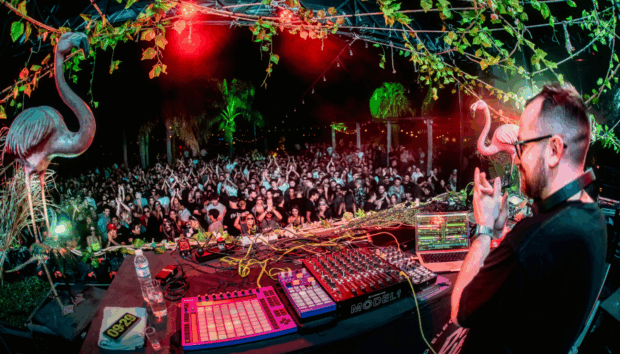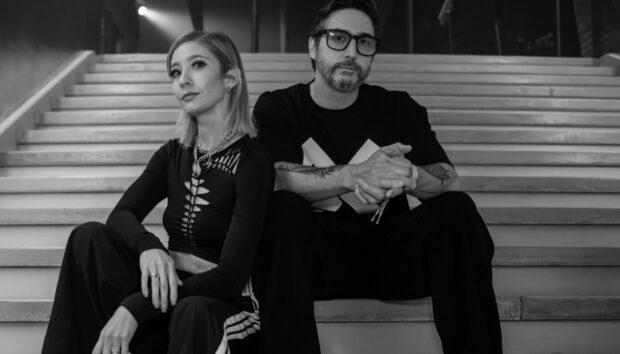Yorkshire-based composer Thomas Ragsdale is living proof that you can crack the clique world of TV advertising and film through independent means. Native Instruments tools have been a key factor, facilitating Ragsdale’s ability to operate solely in the box while introducing Native Kontrol Standard (NKS) to coordinate his myriad of soft synths and plug-ins.
Raised in a home attuned to the sound of The Animals’ House of the Rising Sun, Thomas Ragsdale’s teenage rebellious streak drove his attention towards nu metal, resulting in the purchase of a Fender Strat and 30-watt amp. However, it was at Leeds University where the producer discovered the power and intensity of electronic music. Already a fan of horror and sci-fi soundtracks, Ragsdale’s formative years were spent creating electronic atmospheres for student films and online ads, while painstakingly hawking for work in the industry.
His Bandcamp account eventually found the attention of filmmaker Adam Curtis, leading to Ragsdale’s deeply atmospheric track ‘Warning Mass’ being featured in groundbreaking documentaries for Vice and the BBC. Meanwhile, Domino Publishing added Ragsdale to their esteemed composer roster in the midst of advertising work for major brands including BMW, Prada and Twitter, and score writing for the horror movie Before Dawn and gripping UK thriller, Bait.
By Ragsdale’s own admission, none of this would have been possible without the help of Native Instruments. Integral to his production process, software packages such as KONTAKT, REAKTOR, and THRILL have enabled him to create vast, meticulously crafted cinematic soundscapes. Meanwhile, his production process has been streamlined due to the recent addition of Native Kontrol Standard (NKS), Native Instruments’ extended plug-in format that connects software instruments and effects from over 75 different developers.

Working my way into the industry
I didn’t know what I was doing at first so I got a cheap computer and some really weird old Roland hardware sound processors. All I knew is that I wanted to be like Aphex Twin and Goldie, so I got whatever anyone was selling for £50 and coupled that with a copy of Reason 2, which enabled me to work onscreen and slowly reveal my production aesthetic. I’ve never been London-based and there’s a lot of stigma around having to be where the work is, but I think if you work hard, put yourself out there and make music that feels good to you, that’s what people are more drawn to.
I didn’t really know how to get into advertising the proper way. I could have gone to the London College of Music and got a degree in composing, but instead I paid attention to what’s on TV. I didn’t try to imitate it, but have been influenced by sounds that have become fashionable. I’ve written and released music and stumbled on this eerie, brooding atmospheric sound that I like, and people seem to like it, although pursuing industry contacts that are into that sound has been a lot of hard work.
Making a statement
A lot of TV, film, and music in general, used to be in the background and not making a statement. But the way that films and TV programs are made today is much more music-driven. People are choosing the music first and cutting imagery to it. Quintin Tarantino will choose music and write a film around it, and Darren Aronofsky will choose Clint Mansell for the perfect film score in the same way that David Fincher will use Trent Reznor. I’ve probably listened to more film scores than I’ve watched films. It has its own format – it’s not quite soundtrack, but it’s not an album. When married with film, the music’s normally a lot better, but by becoming its own format, people are taking it a lot more seriously these days.
Working with Bulgari
I didn’t get a phone call out of the blue. I’d signed up with a publisher on the basis of doing weird, atmospheric music and Bulgari was definitely impressed in that side of things, even though the music for the advert was not what I would normally do. I think they were impressed with my credits for TopMan and Prada. Apart from a little guitar, the Bulgari advert was all done in the box. In fact, that’s why I got the job, because there was no time to hire a studio. It was definitely a KONTAKT job for the drums, GUITAR RIG for guitar, and I even used an electric bass plug-in from Kontakt too.
Choosing Ableton
When I tell other composers I use Ableton, they usually laugh at me or look a bit unsure, but I’ve made four film scores and countless commercials using it. I’ve recorded huge 90-minute films with 300 channels of music and never noticed anything that could do it better. Perhaps it’s because I don’t use a lot of audio; I’m a MIDI guy that’s into plug-ins and layering effects. People cite Ableton as a DAW that allows you to get things done quickly, but that’s not how I like to work – I like to enjoy the process and can spend six hours on a sound.
Discovering Native Instruments
I stumbled on Native Instruments in my early days. I’d heard about what plug-ins could do and bought a secondhand copy of BATTERY on eBay. I didn’t even know what it was, but installed it and found it was full of awesome drum sounds. When I got KOMPLETE 2 about ten years ago I thought, oh my god, I’ve got everything now; orchestras, pianos, weird synths. There’s so much in there that I’m still going through it now. I’ve never really dabbled with outboard. With Komplete you get some really good overdrive compressors, like Vari Comp, which I use on everything, and Solid Dynamics. I’m not sure if Native was known for doing effects, but these are awesome.

Finding inspiration
I love using presets. People think they’re ‘false’, but I’ll load a bunch of plug-ins onto a sound, hit play, turn the sound up and suddenly I’ve got something I never would have thought of. I find that our ears can often be too honest and stop you from doing those experiments. Sometimes I’ll just throw it all in, get ten delays on a sound, make a big weird noise and commit to it. For me, there’s two ways of making music, the fun, cool, weird side, and my functional, clinical side for advertising where I’ll use quite a specific set of tools, mostly using KONTAKT.
I get asked to do a lot of things using real drum sounds, so I’ll use the ABBEY ROAD kit for that, and I’ll use GUITAR RIG for anything that needs a Jimi Hendrix-style guitar sound. I’m not too bad at playing a real guitar, but the software has fantastic effects from the ‘60s and ‘70s that are super-easy to use. In my opinion, no one can tell the difference. I’ve also used GUITAR RIG on organs because it’s got a beautiful loop machine. It’s very rudimentary because it only records for seven seconds, but sometimes that’s all you need and those limitations often get the best out of you.
REAKTOR User Library
I’ll use real guitars for the droney stuff, setting effects that you would normally find on a synth with lots of reverb, delay and tape echo sounds to layer up chords or create ambient textures. I like to use a lot of the REAKTOR effects on guitar, and when I’m bored or lacking inspiration I’ll go onto the REAKTOR User Library web page and download random effects that people have posted on there. I’ve found some unbelievable things. There’s this VHS effect plug-in that degrades the sound. It’s really ugly and messy, but gives really nice warmth to everything. No-one can believe how I did it, yet it’s a free effect.
The brilliance of THRILL
I had been dreaming of creating certain sounds for years, like horror soundtrack noises with crazy strings and rattling drums; things I could never do because I didn’t have that equipment, resources or finances. When THRILL came out, I bought it immediately. These guys are doing exactly what I need – easy sounds that you can load up, press one key and get this never-ending, evolving terror. The only thing I don’t like about THRILL is that other people can use it. I’ve done entire scores using 30 different instances, one per scene. The string sounds are so clean and editable that you don’t need to get a good string player in. It’s an absolute miracle of a program, and should cost ten times more.
UNA CORDA Piano
Although Native has always been a great company; they’ve been on fire recently. I got the UNA CORDA piano plug-in for Kontakt and it’s amazing. It has the sort of piano sound that I’ve been trying to find for years. It’s made by Nils Frahm and has a really gentle, super-soft dynamic, with nice effects and some weird stuff built in too. It’s something that I’ve noticed being used in a lot of film scores these days, but couldn’t figure out how to get that sound myself.
Using Native Kontrol Standard (NKS)
NKS is really cool. It goes along with what I’ve been saying about how things seem to have changed at Native Instruments and got even better. It’s amazing for organizing my sound libraries, which is especially useful when I’m working on a massive project. If you’re doing a film score and have something like 200 channels running, Ableton can start to look a bit ugly, so I’ll open up KOMPLETE KONTROL and NKS tidies up all the plug-ins.
Because it’s all categorized and has lovely diagrams, it’s far easier to get the sound I want. For example, if I want strings, I’ll go to NKS instead of opening Kontakt and all my third-party plug-in libraries are there, or I’ll just type in a keyword. It means that I don’t’ have to go through this laborious process of finding plug-ins. I really hope every plug-in manufacturer gets on to this, because it really simplifies my effects chains, especially within complex sound libraries that can be a minefield to trawl through.
It also maps all your software so you’re not looking at millions of dials. I’m quite into using Native Instruments’ GUI interface, and NKS maps it all to look exactly the same whether you’re using ABSYNTH, BATTERY or MASSIVE. For example, if you’re looking for a filter, they’re all in the same place and nicely labeled so you can get straight on with doing whatever you want to do. It’s the same principle as Ableton Push, which maps things to Ableton really nicely.
Honley Civic Archives
My latest release is Honley Civic Archives Volume 1. Over the past six or seven months I’ve managed to record a few string players and capture lots of weird field recordings on my iPhone, so I coupled that with some Spitfire Audio sample libraries like Kontakt’s Olafur Arnalds Evolutions, the Uni Cord piano and Reaktor’s VHS effect. That’s allowed me to make fun drone sounds really quickly to create these big sound collages.
I was influenced by The Cinematic Orchestra, who record hours and hours of music and put it all together to make something interesting. I banged everything through a load of plug-ins and Reaktor delays to make this big, creepy wash of sounds and recorded them into a tape machine, which I’d slow down or speed up by putting my hand on the tape at random intervals. It sounds really eerie, but also really nice, especially if you put a vocal through it. I suppose it’s nice for me to do something with my hands once in a while.
Thomas Ragsdale’s recently released ‘Honey Civic Archives Volume 1’ is available to buy through Soundtracking the Void via Bandcamp.
Photo credits: Danny Payne


















